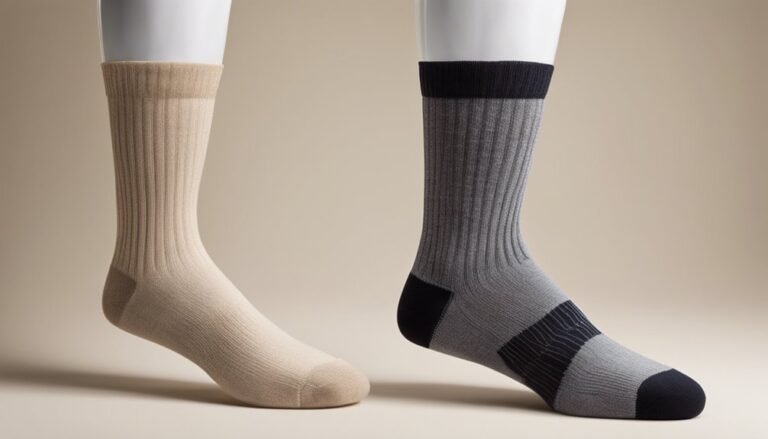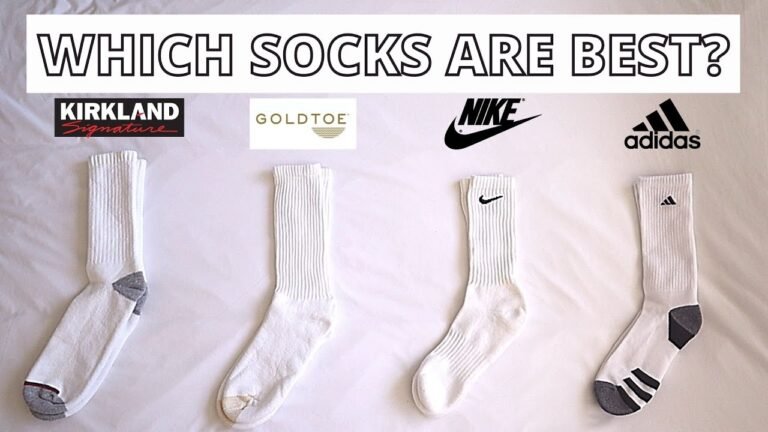Plastic-Free Socks vs. Polyester Socks: Which Is More Eco-Friendly?
When comparing plastic-free socks to polyester socks, plastic-free options are generally more eco-friendly. They're made from organic, biodegradable fibers that lessen landfill waste and support sustainable practices. Polyester socks, while durable and moisture-wicking, rely on harmful production processes that deplete resources and contribute to pollution. Your choice considerably impacts the environment, and understanding these factors can guide you to make better decisions for your wardrobe and the planet. Discover more about these alternatives and their benefits.
Understanding Plastic-Free Socks: Materials and Benefits

When you choose plastic-free socks, you're not just making a fashion statement; you're opting for materials that are better for both your feet and the planet. By selecting socks made from organic fibers, you're supporting sustainable sourcing practices that prioritize the health of the environment. Organic cotton, bamboo, and wool not only feel great against your skin, but they also biodegrade, reducing waste in landfills. Unlike synthetic alternatives, these materials allow your feet to breathe, preventing discomfort and odors. Plus, the production of organic fibers often requires less water and fewer harmful chemicals, aligning with a lifestyle that values freedom from environmental harm. Embracing plastic-free socks is a small but impactful step toward a more sustainable wardrobe.
The Case for Polyester Socks: Durability and Performance
Polyester socks stand out for their impressive durability and performance, making them a popular choice for many consumers. When you choose polyester, you're opting for a fabric that can withstand wear and tear, perfect for active lifestyles. The polyester benefits include moisture-wicking properties that keep your feet dry and comfortable, especially during workouts or long hikes. Plus, they dry quickly, preventing unpleasant odors. With a range of performance features like breathability and stretch, polyester socks adapt to your movements, offering support without sacrificing comfort. While plastic-free alternatives have their merits, polyester socks deliver reliability that can't be overlooked. For those who value performance and longevity, polyester socks remain a compelling option in the world of footwear.
Environmental Impact of Production Processes
While many appreciate the durability and performance of polyester socks, it's crucial to reflect on the environmental impact of their production processes. The production of polyester is far from sustainable, often leading to significant resource consumption and pollution. Here are some critical points to contemplate:
- High energy usage during production contributes to carbon emissions.
- Toxic chemicals are often released into waterways, harming ecosystems.
- Polyester manufacturing relies heavily on fossil fuels, depleting nonrenewable resources.
- Waste generated from synthetic fibers clogs landfills and oceans.
Longevity and End-of-Life Considerations

Although many consumers prioritize immediate comfort and performance, the longevity and end-of-life considerations of socks can considerably influence their overall environmental footprint. When it comes to eco-friendliness, how long your socks last and what you do with them at the end of their life matters.
| Socks Type | Recycling Options |
|---|---|
| Plastic-Free Socks | Biodegradable, compostable options available |
| Polyester Socks | Limited recycling programs; often end in landfills |
Choosing durable socks can reduce the frequency of replacements. Additionally, exploring disposal methods, like donating or recycling, can minimize waste. Making informed choices about longevity and end-of-life can empower you to tread lightly on our planet.
Consumer Choices and Their Influence on Sustainability
Your choices as a consumer play an essential role in shaping sustainability in the fashion industry. When you opt for sustainable materials, you're not just making a personal statement; you're influencing demand and encouraging brands to prioritize eco-friendly practices. Understanding this connection can empower you to make decisions that contribute to a healthier planet.
Sustainable Material Selection
Choosing sustainable materials for everyday items like socks can considerably impact the environment, especially when you consider the alternatives available. By opting for biodegradable options and organic materials, you can make a meaningful difference. Here's what to keep in mind when selecting your socks:
- Biodegradable fibers break down naturally, reducing landfill waste.
- Organic cotton uses fewer chemicals, promoting healthier ecosystems.
- Bamboo is a fast-growing resource that requires minimal water.
- Recycled materials help divert waste from landfills and reduce new plastic production.
Your choices matter, and by prioritizing sustainable materials, you're not just making a fashion statement; you're contributing to a healthier planet. Every pair of socks you buy can reflect your commitment to eco-friendliness and freedom from harmful practices.
Impact of Consumer Demand
As consumer awareness of sustainability grows, so does the power of individual choices in shaping market trends. Your preferences directly influence which products succeed. When you opt for plastic-free socks over polyester, you're not just making a fashion statement; you're impacting the industry's direction. Brands notice the shift in consumer demand and often adapt their offerings accordingly. This means more sustainable options could become readily available if enough people prioritize eco-friendly choices. However, it is crucial to remain critical; not all "green" products are genuinely sustainable. By staying informed about the real impact of your purchases, you empower yourself and others to drive meaningful change. Remember, your choices today can redefine tomorrow's market landscape.
Making the Best Choice for Your Wardrobe and the Planet
When you're choosing between plastic-free and polyester socks, consider their environmental impact and how long they'll last in your wardrobe. Each option has its pros and cons, affecting not just your comfort but also the planet's health. Making an informed choice means weighing durability against sustainability, so let's explore what matters most to you.
Environmental Impact Comparison
While it might seem trivial, the choice between plastic-free socks and polyester socks can greatly impact the environment. By opting for plastic-free options, you're supporting sustainable practices that reduce reliance on fossil fuels. Polyester, on the other hand, is derived from plastic and often contributes to microplastic pollution.
Consider these points:
- Plastic-free socks often use natural fibers, which are biodegradable.
- Polyester socks may offer recycling options, but the process is less efficient.
- The production of natural fibers generally has a lower carbon footprint.
- Choosing eco-friendly socks can inspire others to follow suit.
Ultimately, when you make conscious choices for your wardrobe, you're not just dressing yourself; you're nurturing our planet's future.
Material Durability and Longevity
Choosing the right socks isn't just about comfort; it also involves considering how long they'll last. The durability of your socks impacts not just your wallet but the planet too.
| Sock Type | Material Resilience |
|---|---|
| Plastic-Free Socks | High (Organic Fibers) |
| Polyester Socks | Moderate (Synthetic) |
Plastic-free socks, made from natural materials, typically offer better fabric lifespan, resisting wear and tear. They're often biodegradable, reducing long-term waste. In contrast, polyester socks can endure rigorous use but may contribute to microplastic pollution upon disposal.
When you choose your socks, think about the balance between comfort, longevity, and environmental impact. Making informed choices not only enhances your wardrobe but also promotes a sustainable lifestyle.
Frequently Asked Questions
Are Plastic-Free Socks More Expensive Than Polyester Socks?
Did you know that sustainable materials can sometimes cost up to 20% more due to the complex material sourcing? In a cost comparison, plastic-free socks often come at a higher price than their polyester counterparts.
How Do I Properly Care for Plastic-Free Socks?
To care for your plastic-free socks, wash them sustainably in cold water to preserve fibers. Avoid harsh detergents, and air dry to prevent damage. This also helps with odor prevention, keeping your socks fresh longer.
Can Polyester Socks Be Recycled?
You might think recycling polyester socks is straightforward, but it's complex. While some facilities accept them, the recycling process can impact the environment negatively. Always check local guidelines to guarantee proper disposal and minimize harm.
What Brands Offer Eco-Friendly Sock Options?
You'll find several sustainable brands offering eco-friendly sock options. Look for those using ethical materials like organic cotton or bamboo. These choices not only support the environment but also provide comfort and style for your feet.
How Do I Know if Socks Are Truly Plastic-Free?
To know if socks are truly plastic-free, check for sustainable materials and look for sock certifications. Research brands that prioritize transparency, as they often provide details about their materials and production practices, ensuring eco-friendliness.







